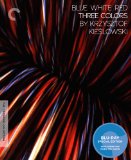| Reviews & Columns |
|
Reviews DVD TV on DVD Blu-ray 4K UHD International DVDs In Theaters Reviews by Studio Video Games Features Collector Series DVDs Easter Egg Database Interviews DVD Talk Radio Feature Articles Columns Anime Talk DVD Savant Horror DVDs The M.O.D. Squad Art House HD Talk Silent DVD
|
DVD Talk Forum |
|
|
| Resources |
|
DVD Price Search Customer Service #'s RCE Info Links |
|
Columns
|
|
|
Three Colors: Blue, White, Red - The Criterion Collection
THE MOVIE:
Please Note: The images used here are promotional stills for the film and are not taken from the Blu-ray edition under review.
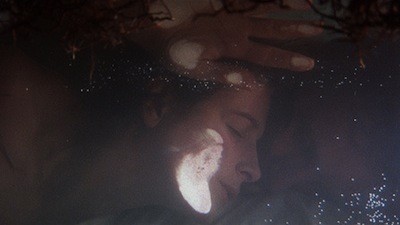
It seems to me that Krzysztof Kieslowski's Three Colors should be one of those cinema experiences where how one first saw it is as important as how it affected him or her. True movie fans know what I mean. It's much the same way certain songs become tied to a particular time and place, creating a soundtrack for our memories. So too does how we interact with a movie make a difference for how meaningful it becomes in our personal library. For instance, I saw Three Colors for the first time over the course of two nights. Blue and White were the first night, Red the second. This was within the same year that Red had been released, either 1994 or 1995, and I made sure to catch them in the order of release.
That was, however, not necessary. Kieslowski built his threesome in such a way that they need not be enjoyed in any particular order. How you shuffle these cards will inform how you examine the images as a whole. Each movie stands alone, though they do cross over one another in small ways that you will recognize as you watch them all, but perhaps will be more or less meaningful depending on which of the films you have already seen. I stuck to the safe route, and have done so ever since. My second viewing was when Starz aired them in the same order over the course of three weeks, back when every Monday night was reserved for a spotlit foreign film. (I saw many important movies via that Monday night programming, including my first exposure to Belle Du Jour.) My last time watching all three was over one New Year's holiday back in 2003, when Three Colors first came to DVD. I'm a purist, what can I say? I like my routine.

Kieslowski named each of his three films for the three colors on the French flag, and thematically, he loosely touches on what those colors symbolize--liberty, equality, and fraternity--though like his infamous fableization of the Ten Commandments, The Decalogue, there is a mysteriousness to how exactly the core ideas are represented. The greater meaning of Three Colors (or Trois Coleurs depending on what side of the pretention border you live on (or, I guess, the literal geographical border)) and how it ties to these morals is in the way they blend together, how the three individual films work in concert. While you could view one or two of the three and never see the others and enjoy those films all the same, their impact as whole is easily greater than the sum of their parts. Be it the mourning of Blue or the comedic romance of White or the sweet and sad fumblings between young and old in Red, all of these films are stories of human connection, of the freedoms that bring us together and that also separate us, and what we do to try to close the divide and end the isolation and loneliness that in some way we all feel as a byproduct of the modern condition. This is end-of-the-20th-Century, pre-millennial stuff. How far apart we had grown and how we could bring it back together seemed super important back then, and while the hope of new technology was that it would make the world smaller and unite us, the sad truth is it's only made the alienation more exact.
Juliette Binoche stars in the lead film, Blue (Bleu), as Julie, a woman struggling to feel something again after surviving a car crash that claimed her husband and child. Julie's spouse was a famous composer who had been hired to compose a special symphony for the unification of Europe--an event that will be on the horizon in all three films. His death leaves the work unfinished, and Julie tries to squash it along with everything else from her past. She sells their home, discards her possessions, and attempts to drop out and forget--a particularly poignant act that takes on added emotional weight when we later discover that her mother (Emmanuelle Riva) is suffering from Alzheimer's. Julie is struggling to forget and can't, while her mother struggles to remember.
If Blue is to represent "liberty," then its central expression is Julie's search for freedom from her past, for a life where she can live as an individual with no ties or responsibilities to others. This proves impossible, however, as she becomes involved with her neighbors, her husband's assistant (Benoit Regent), and the mistress (Florence Pernel) she never knew about. In some way they all serve to remind her of what it's like to feel. The assistant, Olivier, wants to love her; Lucille (Charlotte Very), who works as a stripper and a prostitute, shows her that it's okay to enjoy pleasure. The thread running through all this is the music, the melodies that she can't deny, that come to her even in the street when a random flautist plays a song he couldn't possibly know. This symphony that is supposed to bring together all people eventually sews all of these elements together for Julie, too, unleashing the emotion she has sought to suppress.
Juliette Binoche is remarkable as Julie. Her performance is fragile, controlled, and entirely heartfelt. Though the script demands a certain cold reserve, the actress summons subtle flare-ups of anger, disappointment, and pain. Blue could have been a heavy movie, or it could have been an empty experience had the lead actress merely tried to play Julie like an unfeeling robot. Instead, Binoche gifts Kieslowski with maybe the finest and most distinctly rendered performance of her career. In return, Kieslowski and cinematographer Slawomir Idziak create a chilly, yet often dreamy, world of placid images infused with darker hues of blue and black, the colors of Julie's grief. A recurring image of a hanging mobile made of blue crystals acts as a rosary, and as a shimmering beacon for Julie to focus her muddled intentions.
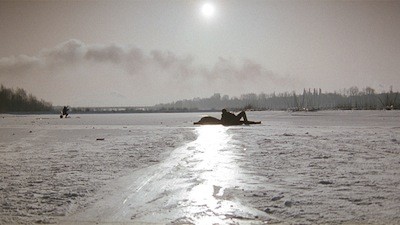
Julie's story crosses over with the estranged lovers in White (Blanc) only briefly. In Blue, she goes to see her husband's mistress at the courthouse where she works and accidentally peeks in on a divorce proceeding. That case is the opening scene of White. Beautiful French beautician Dominique (Julie Delpy, 2 Days in Paris) is divorcing Polish immigrant Karol Karol (Zbigniew Zamachowski), himself a prize-winning hairdresser. Their romance was passionate before marriage, but since, Karol has been unable to perform. This is just one symptom of a greater malady, one that strikes many couples but especially here: an inability to communicate. Karol barely speaks French, Dominique doesn't speak Polish.
Destitute and living on the streets, Karol sneaks back to Poland with the help of Mikolaj (Janusz Gajos). He literally rides home as luggage, tucked into his suitcase! Once he is back on his own soil, Karol undergoes a transformation. Rather than cutting hair, he starts working for a local gangster and eventually finds information that allows him to undercut his boss and make a lot of money to start his own business with Mikolaj. His goal isn't the creature comforts money will buy, however, but to amass enough cash to enact an elaborate scheme to get Dominique back. "Get her back" as in "get back together with her," but also "get her back for what she did."
White is a subtly comic dissection of union and division. The obvious focus is marriage, but the inequality arises in other areas. There is husband and wife, man and woman, but also class. There is the difference between natives and immigrants, an interesting and troublesome complication at the time of the establishment of the European Union. (When Karol gets home, he notices his brother has added a neon sign to their salon. "We're European now," the brother explains.) This is, after all, the portion of the flag that represents "equality." Dominique holds all the cards at the start of the film, it's her country and her language. It's also more simple than that: she is the one with the upper hand in the relationship. Love is often lopsided, with one being more in love than the other, and the other tends to have the advantage.
Zbigniew Zamachowski is wholly sympathetic as Karol Karol. The actor grows the performance, letting it blossom and mature. Karol goes from destitute and impotent to powerful, yet he is warm-hearted throughout. Zamachowski remembers that, deep down, this man is a lover and, let's face it, sensitive. He does hair for a living, he is not a thug. His growth also humanizes the object of his desire. Before leaving France, he buys a porcelain figure that reminds him of Dominique's alabaster skin. Yet, that false idol breaks as soon as he gets out of the suitcase, and over the course of his mission, his image of her also shatters, revealing the tender, delicate woman he failed to understand before (she tells him of her weakness, just before she shows him her strength, in their last time together in Paris). Ironically, it is separation that has brought them together, and the consequence of Karol's conspiracy is that they are still separated, even if the exile is now shared.
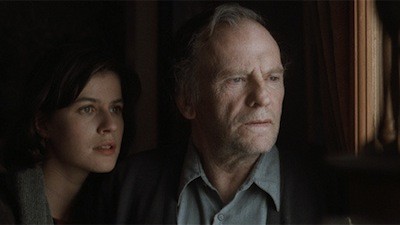
If division is a strong central theme in White, then the final film in the series, Red (Rouge), is about all the things that bring us together. The brotherhood of man is linked in inexplicable, yet heartening ways.
The film stars Irene Jacob, the luminous star of Kieslowski's previous masterwork, The Double Life of Veronique. Jacob plays Valentine, a young model with a good heart living in Geneva. When she accidentally hits a dog with her car, she tracks down her owner to make amends. The man she finds is an aging, retired judge (Jean-Louis Trintignant, Z, Le combat dans l'ile) who has removed himself from outside life and spends his days eavesdropping on his neighbors' cell phone calls. Valentine is at first appalled, but she enters into a moral debate with the old man and they become friends. His years wearing the robe of justice have given him a keen sense of human nature, though he is not prepared when his young companion turns the tables on him and puts together the puzzle of his life.
The judge's painful past is not the only puzzle in Red. Kieslowski's script, co-written with Krzysztof Piesiewicz (as is the entire trilogy), creates a tricky yet lithe map of doubles and parallels. The judge's experience as a young man matches that of a young law student (Jean-Pierre Lorit), and the old man's dissection of time and dreams of a future he will not be a part of has more than once made me think that Kieslowski is playing with knowable space in much the same way that he did in Veronique. These two men are the same, and they exist in time both separate and together. I don't think that was Kieslowski's intended meaning, necessarily, but it gives Red some interesting nuance.
The construction of this delicate set-up is really quite extraordinary. The young man, Auguste, lives just a few buildings down from Valentine, and his girlfriend (Frederique Feder) is one of the neighbors that the judge is listening in on. The old man predicts the failure of their relationship long before it's a reality. Kieslowski stages some wonderful scenes where the two couples move around each other without noticing, including some breathtaking choreography on the street outside of Valentine's apartment, where the camera shifts from her arriving at home and going upstairs to Auguste leaving a store and crossing her path.
Jacob is, unsurprisingly, alluring and soulful as Valentine. She avoids playing her as a mere innocent, and instead makes the character someone who feels intensely. Frivolity seems to be denied her. We see her on a photoshoot for a chewing gum ad, but the company doesn't pick the fun pictures of her blowing bubbles, instead going with a shot that is more mysterious and almost sad. A bad boyfriend who appears as a disembodied voice on the phone berates her for not being available and quizzes her over her every move. As she eventually ends up drawing the judge out of his shell, so does he encourage her to let go of certain anxieties. Trintignant makes for a nice foil to the young woman. He is brittle and unkempt to start, but slowly he reveals an empathetic soul.
Naturally, Krzysztof Kieslowski ends this personal epic on a note of hope. The final scene of Red ties all three films together in such a way that leads us to believe that all the people we've seen--Julie and Olivier, Karol and Dominique, and Valentine and Auguste, all couples with the promise of love--are going to be okay, that for all the dangerous happenstance of existence, their lives will carry on and, by extension, so can ours. Three Colors is a deft and beautiful summation of the 20th Century, of the promises for a future we hoped would be kept and of the collective fear that they may not. Kieslowski's endnote is that such fears are immaterial, they are beyond our control; yet, if we hang on to one another and listen to our hearts, everything will be fine.
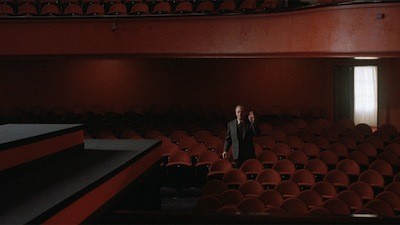
THE BLU-RAY
Video:
The 1080p high-definition image, encoded at MPEG-4 AVC, for all three films is nothing short of astounding. Blue is subtle and cool and beautifully dark, while White's chilliness captures the sparkling blankness of sunlight on snow. All of the films have rich and wonderful colors, with natural skin tones and excellent rendering of texture. The grain is properly balanced to give the movies an appropriate filmic look without being overpowering. I can't find a single fault here.
Sound:
The original French language soundtracks have been remixed in 2.0 DTS-HD Master Audio and sound wonderful. Dialogue is given nuance and music is given bombast and the appropriate impact to convey the director's intentions. Sound effects have nice resonance, as well. In Blue, when the baby mice are crying, something primal came to life in my cat. She heard the noise, woke up from a nap, and stared at the television until the moment had passed. I've never seen her with a mouse in my life!
The optional English subtitles read well and are paced so they are easy to follow.
Extras:
Criterion has created a lovely boxed set here, with each movie given its own cardboard sleeve, fitting in the outer slipcover alongside the thick supplemental booklet. In terms of bonus features, there are quite a few new ones, as well as several carryovers from the 2003 Miramax release--though not all of them, so Kieslowski devotees may want to keep that set. I will indicate which supplements are repeats by putting a # symbol after the name.
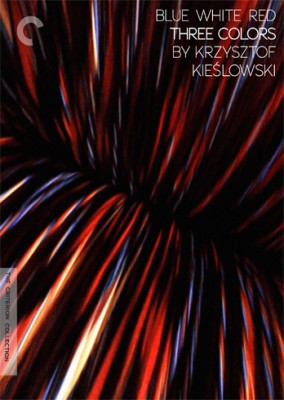
On Blue, the extras are as follows:
* Cinema lesson with director Krzysztof Kieslowski (7:30) #: The director give a detailed look at the sugar-cube scene.
* Video essay by film studies professor Annette Insdorf (20:45): Insdorf, a Kieslowski expert, presents her interpretation of the film, putting across many of the ideas that she shared in her prior audio commentary, which is not available on this release.
* Interview with Three Colors composer Zbigniew Preisner (21:30)
* Select scene commentary with Juliette Binoche (24:30) #
* "Reflections on Blue" (17:30)/ "Kieslowski: The Early Years (15:00) #: Documentaries on the film and the filmmaker featuring collaborators and admirers.
* "The Tram" (5:30) #: A short film by Krzysztof Kieslowski from 1966 (previously available on the White DVD as "Trolley").
* "The Face" (6:00) #: A short film from the same year starring the director (also previously on White).
* Theatrical Trailer
The extras on White:
* Cinema lesson with director Krzysztof Kieslowski (10:50) #: Kieslowski dissects the opening sequence of the second movie.
* Video essay by Tony Rayns (21:50): An insightful new critical feature looking at the themes and styles in the film.
* Two new interviews: (1) co-writer Krzysztof Piesiewicz (21:20) and (2) White actors Zbigniew Zamachowski and Julie Delpy (18:15)
* "A Look at White" (16:00) #: A behind-the-scenes featuring the director.
* Two short documentaries by Kieslowski: (1) "Seven Women of Different Ages" (16:15) and (2) "Talking Heads" (14:50) From 1978 and 1980, respectively, featuring explorations of small aspects of life, including looking at specific ballet dancers in the first and a wider range of people in the second, posing basic questions and looking for different answers. The use of different timelines that parallel one another and the cross-sectioning of experience would become a hallmark of Kieslowski's work, particularly in Three Colors, so it makes sense to include them here.
* Theatrical Trailer
The extras on Red:
* Cinema lesson with director Krzysztof Kieslowski (8:40) #: A look at the scene when Valentine lets the dog go and it runs home.
* Video essay by film writer Dennis Lim (22:00)
* Interview with Irene Jacob (16:25)
* Interview with producer Marin Karmitz (10:50) #
* Interview with editor Jacques Witta (12:45) #
* Behind-the-scenes footage (23:30) #
* Featurette on the Cannes premiere (15:10) #
* Krzysztof Kieslowski: I'm So-So... (55:35): A 1995 documentary examining the director's career, completed just before his death (Red was his final film, though he left behind scripts that were later produced by others).
* Theatrical Trailer
All the extras are presented in high-definition.
FINAL THOUGHTS:
DVD Talk Collector Series. Three Colors: The Criterion Collection is a can't-miss Blu-Ray set. Krzysztof Kieslowski's trilogy is a marvel of cinema. It is thoughtful without being ponderous, philosophical without being preachy, and at all times, deeply human. Whether the subject is love or death or all the things that happen in between, the director handles each with a delicate hand and a visual aplomb that is unmatched. These movies--Blue, White, and Red--must be experienced by all cinema lovers. I can only explain their triumphs to a shallow degree, my words are inadequate. See Three Colors for yourself, and you will believe.
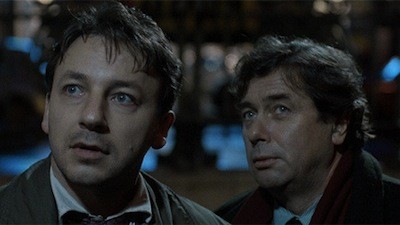
Jamie S. Rich is a novelist and comic book writer. He is best known for his collaborations with Joelle Jones, including the hardboiled crime comic book You Have Killed Me, the challenging romance 12 Reasons Why I Love Her, and the 2007 prose novel Have You Seen the Horizon Lately?, for which Jones did the cover. All three were published by Oni Press. His most recent projects include the futuristic romance A Boy and a Girl with Natalie Nourigat; Archer Coe and the Thousand Natural Shocks, a loopy crime tale drawn by Dan Christensen; and the horror miniseries Madame Frankenstein, a collaboration with Megan Levens. Follow Rich's blog at Confessions123.com.
|
| Popular Reviews |
| Sponsored Links |
|
|
| Sponsored Links |
|
|
| Release List | Reviews | Shop | Newsletter | Forum | DVD Giveaways | Blu-Ray | Advertise |
|
Copyright 2024 DVDTalk.com All Rights Reserved. Legal Info, Privacy Policy, Terms of Use,
Manage Preferences,
Your Privacy Choices | |||||||









